Nursing and Case Study | Assignment
VerifiedAdded on 2022/09/06
|5
|2139
|43
AI Summary
Contribute Materials
Your contribution can guide someone’s learning journey. Share your
documents today.
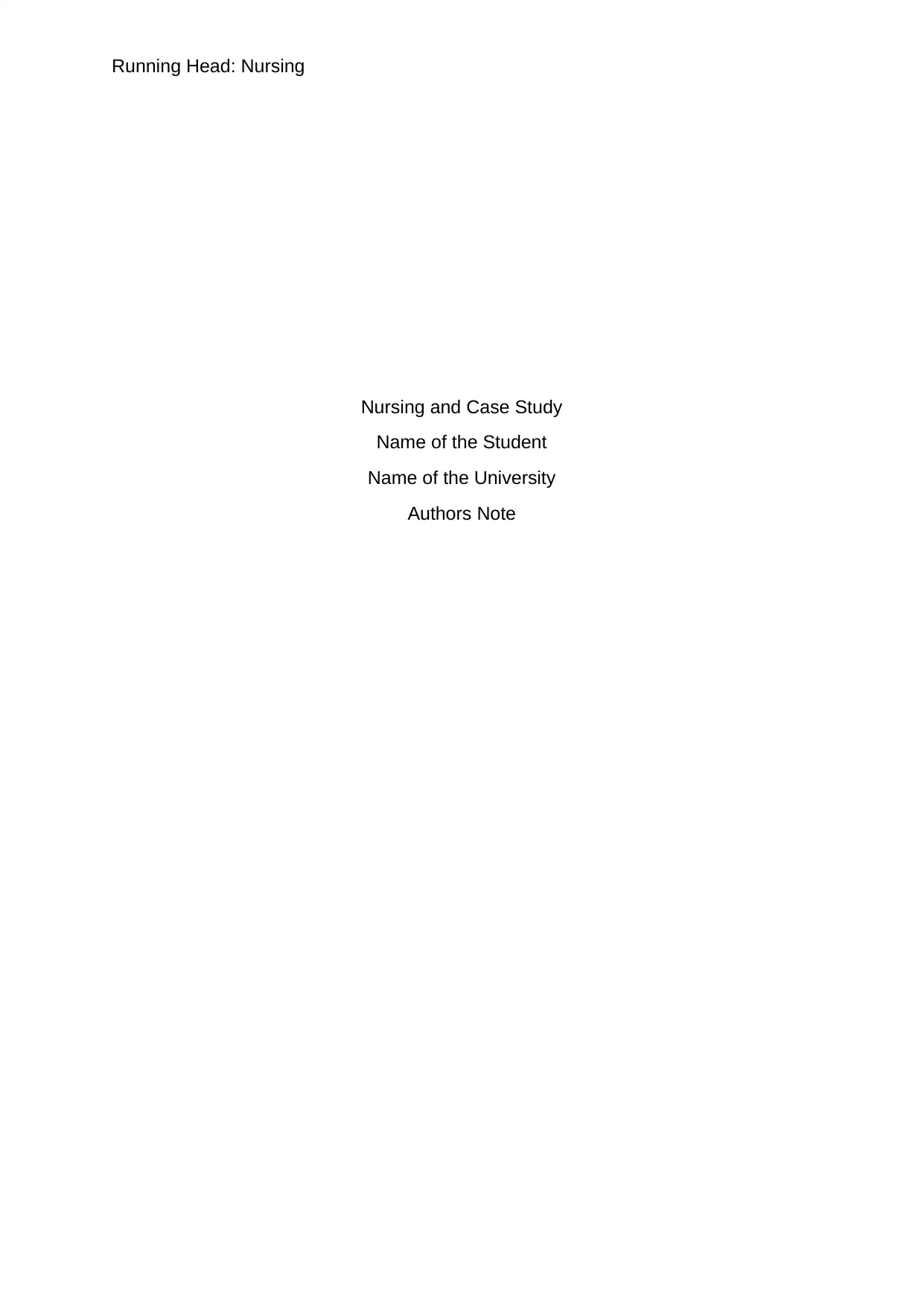
Running Head: Nursing
Nursing and Case Study
Name of the Student
Name of the University
Authors Note
Nursing and Case Study
Name of the Student
Name of the University
Authors Note
Secure Best Marks with AI Grader
Need help grading? Try our AI Grader for instant feedback on your assignments.
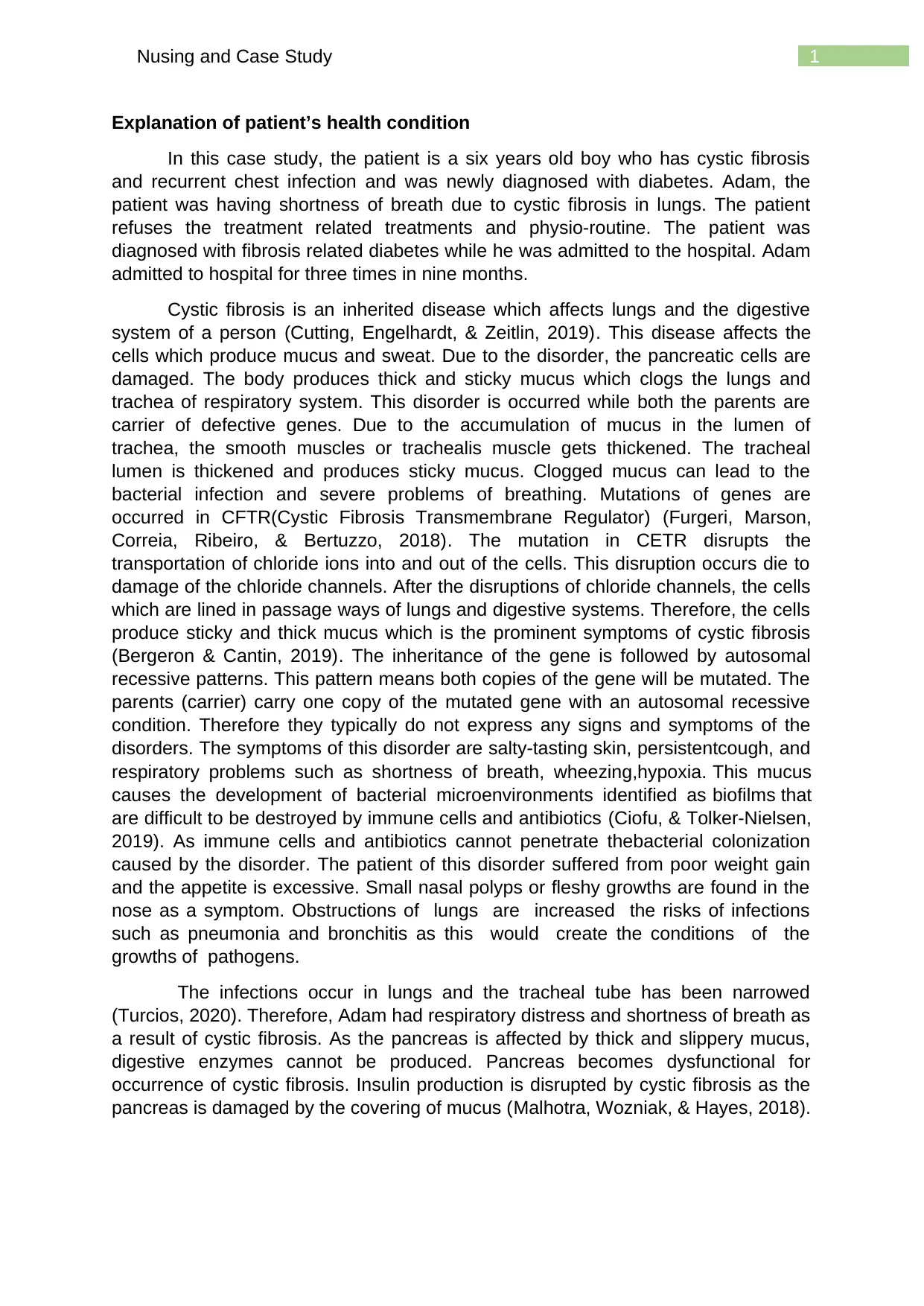
1Nusing and Case Study
Explanation of patient’s health condition
In this case study, the patient is a six years old boy who has cystic fibrosis
and recurrent chest infection and was newly diagnosed with diabetes. Adam, the
patient was having shortness of breath due to cystic fibrosis in lungs. The patient
refuses the treatment related treatments and physio-routine. The patient was
diagnosed with fibrosis related diabetes while he was admitted to the hospital. Adam
admitted to hospital for three times in nine months.
Cystic fibrosis is an inherited disease which affects lungs and the digestive
system of a person (Cutting, Engelhardt, & Zeitlin, 2019). This disease affects the
cells which produce mucus and sweat. Due to the disorder, the pancreatic cells are
damaged. The body produces thick and sticky mucus which clogs the lungs and
trachea of respiratory system. This disorder is occurred while both the parents are
carrier of defective genes. Due to the accumulation of mucus in the lumen of
trachea, the smooth muscles or trachealis muscle gets thickened. The tracheal
lumen is thickened and produces sticky mucus. Clogged mucus can lead to the
bacterial infection and severe problems of breathing. Mutations of genes are
occurred in CFTR(Cystic Fibrosis Transmembrane Regulator) (Furgeri, Marson,
Correia, Ribeiro, & Bertuzzo, 2018). The mutation in CETR disrupts the
transportation of chloride ions into and out of the cells. This disruption occurs die to
damage of the chloride channels. After the disruptions of chloride channels, the cells
which are lined in passage ways of lungs and digestive systems. Therefore, the cells
produce sticky and thick mucus which is the prominent symptoms of cystic fibrosis
(Bergeron & Cantin, 2019). The inheritance of the gene is followed by autosomal
recessive patterns. This pattern means both copies of the gene will be mutated. The
parents (carrier) carry one copy of the mutated gene with an autosomal recessive
condition. Therefore they typically do not express any signs and symptoms of the
disorders. The symptoms of this disorder are salty-tasting skin, persistentcough, and
respiratory problems such as shortness of breath, wheezing,hypoxia. This mucus
causes the development of bacterial microenvironments identified as biofilms that
are difficult to be destroyed by immune cells and antibiotics (Ciofu, & Tolker-Nielsen,
2019). As immune cells and antibiotics cannot penetrate thebacterial colonization
caused by the disorder. The patient of this disorder suffered from poor weight gain
and the appetite is excessive. Small nasal polyps or fleshy growths are found in the
nose as a symptom. Obstructions of lungs are increased the risks of infections
such as pneumonia and bronchitis as this would create the conditions of the
growths of pathogens.
The infections occur in lungs and the tracheal tube has been narrowed
(Turcios, 2020). Therefore, Adam had respiratory distress and shortness of breath as
a result of cystic fibrosis. As the pancreas is affected by thick and slippery mucus,
digestive enzymes cannot be produced. Pancreas becomes dysfunctional for
occurrence of cystic fibrosis. Insulin production is disrupted by cystic fibrosis as the
pancreas is damaged by the covering of mucus (Malhotra, Wozniak, & Hayes, 2018).
Explanation of patient’s health condition
In this case study, the patient is a six years old boy who has cystic fibrosis
and recurrent chest infection and was newly diagnosed with diabetes. Adam, the
patient was having shortness of breath due to cystic fibrosis in lungs. The patient
refuses the treatment related treatments and physio-routine. The patient was
diagnosed with fibrosis related diabetes while he was admitted to the hospital. Adam
admitted to hospital for three times in nine months.
Cystic fibrosis is an inherited disease which affects lungs and the digestive
system of a person (Cutting, Engelhardt, & Zeitlin, 2019). This disease affects the
cells which produce mucus and sweat. Due to the disorder, the pancreatic cells are
damaged. The body produces thick and sticky mucus which clogs the lungs and
trachea of respiratory system. This disorder is occurred while both the parents are
carrier of defective genes. Due to the accumulation of mucus in the lumen of
trachea, the smooth muscles or trachealis muscle gets thickened. The tracheal
lumen is thickened and produces sticky mucus. Clogged mucus can lead to the
bacterial infection and severe problems of breathing. Mutations of genes are
occurred in CFTR(Cystic Fibrosis Transmembrane Regulator) (Furgeri, Marson,
Correia, Ribeiro, & Bertuzzo, 2018). The mutation in CETR disrupts the
transportation of chloride ions into and out of the cells. This disruption occurs die to
damage of the chloride channels. After the disruptions of chloride channels, the cells
which are lined in passage ways of lungs and digestive systems. Therefore, the cells
produce sticky and thick mucus which is the prominent symptoms of cystic fibrosis
(Bergeron & Cantin, 2019). The inheritance of the gene is followed by autosomal
recessive patterns. This pattern means both copies of the gene will be mutated. The
parents (carrier) carry one copy of the mutated gene with an autosomal recessive
condition. Therefore they typically do not express any signs and symptoms of the
disorders. The symptoms of this disorder are salty-tasting skin, persistentcough, and
respiratory problems such as shortness of breath, wheezing,hypoxia. This mucus
causes the development of bacterial microenvironments identified as biofilms that
are difficult to be destroyed by immune cells and antibiotics (Ciofu, & Tolker-Nielsen,
2019). As immune cells and antibiotics cannot penetrate thebacterial colonization
caused by the disorder. The patient of this disorder suffered from poor weight gain
and the appetite is excessive. Small nasal polyps or fleshy growths are found in the
nose as a symptom. Obstructions of lungs are increased the risks of infections
such as pneumonia and bronchitis as this would create the conditions of the
growths of pathogens.
The infections occur in lungs and the tracheal tube has been narrowed
(Turcios, 2020). Therefore, Adam had respiratory distress and shortness of breath as
a result of cystic fibrosis. As the pancreas is affected by thick and slippery mucus,
digestive enzymes cannot be produced. Pancreas becomes dysfunctional for
occurrence of cystic fibrosis. Insulin production is disrupted by cystic fibrosis as the
pancreas is damaged by the covering of mucus (Malhotra, Wozniak, & Hayes, 2018).
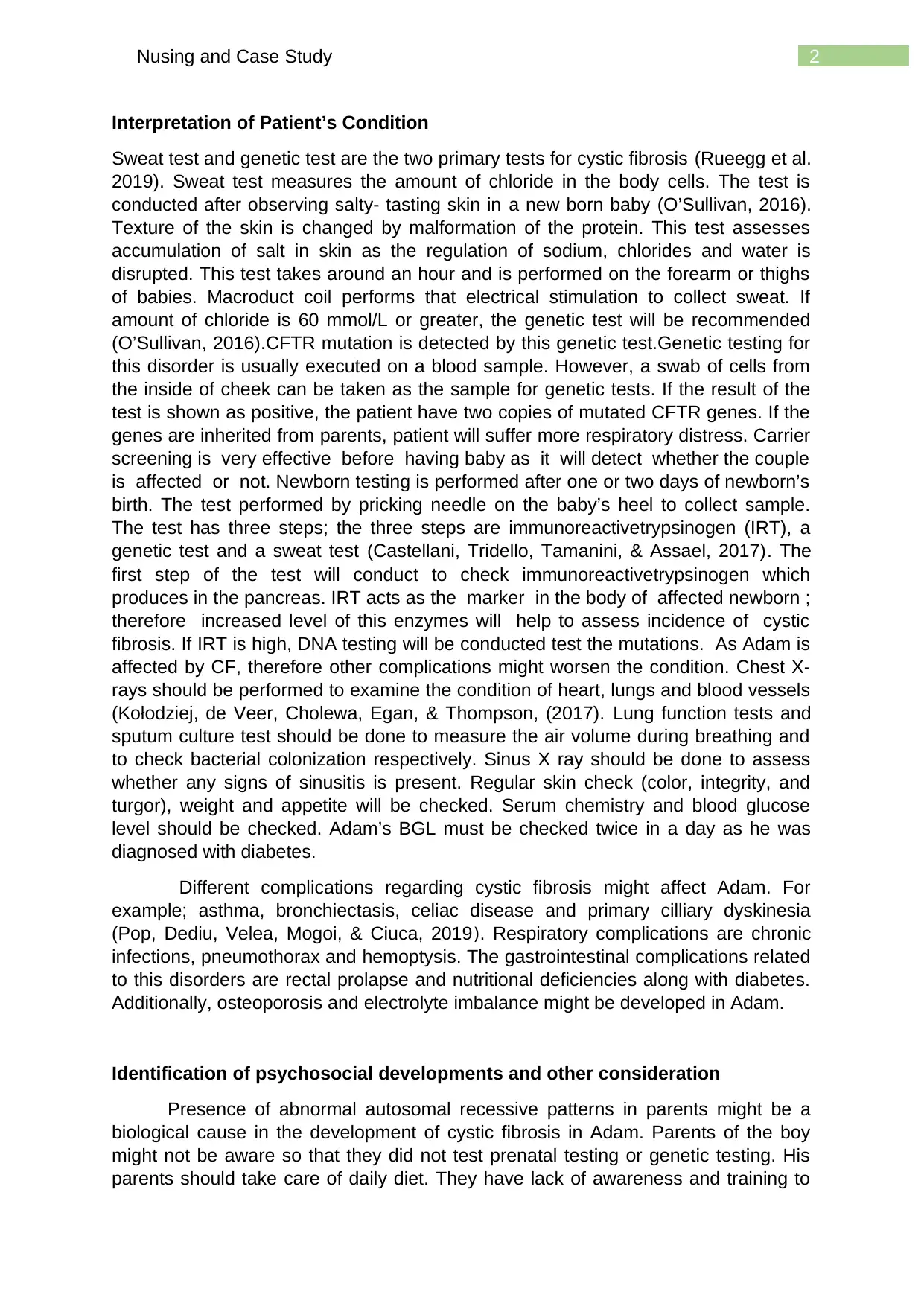
2Nusing and Case Study
Interpretation of Patient’s Condition
Sweat test and genetic test are the two primary tests for cystic fibrosis (Rueegg et al.
2019). Sweat test measures the amount of chloride in the body cells. The test is
conducted after observing salty- tasting skin in a new born baby (O’Sullivan, 2016).
Texture of the skin is changed by malformation of the protein. This test assesses
accumulation of salt in skin as the regulation of sodium, chlorides and water is
disrupted. This test takes around an hour and is performed on the forearm or thighs
of babies. Macroduct coil performs that electrical stimulation to collect sweat. If
amount of chloride is 60 mmol/L or greater, the genetic test will be recommended
(O’Sullivan, 2016).CFTR mutation is detected by this genetic test.Genetic testing for
this disorder is usually executed on a blood sample. However, a swab of cells from
the inside of cheek can be taken as the sample for genetic tests. If the result of the
test is shown as positive, the patient have two copies of mutated CFTR genes. If the
genes are inherited from parents, patient will suffer more respiratory distress. Carrier
screening is very effective before having baby as it will detect whether the couple
is affected or not. Newborn testing is performed after one or two days of newborn’s
birth. The test performed by pricking needle on the baby’s heel to collect sample.
The test has three steps; the three steps are immunoreactivetrypsinogen (IRT), a
genetic test and a sweat test (Castellani, Tridello, Tamanini, & Assael, 2017). The
first step of the test will conduct to check immunoreactivetrypsinogen which
produces in the pancreas. IRT acts as the marker in the body of affected newborn ;
therefore increased level of this enzymes will help to assess incidence of cystic
fibrosis. If IRT is high, DNA testing will be conducted test the mutations. As Adam is
affected by CF, therefore other complications might worsen the condition. Chest X-
rays should be performed to examine the condition of heart, lungs and blood vessels
(Kołodziej, de Veer, Cholewa, Egan, & Thompson, (2017). Lung function tests and
sputum culture test should be done to measure the air volume during breathing and
to check bacterial colonization respectively. Sinus X ray should be done to assess
whether any signs of sinusitis is present. Regular skin check (color, integrity, and
turgor), weight and appetite will be checked. Serum chemistry and blood glucose
level should be checked. Adam’s BGL must be checked twice in a day as he was
diagnosed with diabetes.
Different complications regarding cystic fibrosis might affect Adam. For
example; asthma, bronchiectasis, celiac disease and primary cilliary dyskinesia
(Pop, Dediu, Velea, Mogoi, & Ciuca, 2019). Respiratory complications are chronic
infections, pneumothorax and hemoptysis. The gastrointestinal complications related
to this disorders are rectal prolapse and nutritional deficiencies along with diabetes.
Additionally, osteoporosis and electrolyte imbalance might be developed in Adam.
Identification of psychosocial developments and other consideration
Presence of abnormal autosomal recessive patterns in parents might be a
biological cause in the development of cystic fibrosis in Adam. Parents of the boy
might not be aware so that they did not test prenatal testing or genetic testing. His
parents should take care of daily diet. They have lack of awareness and training to
Interpretation of Patient’s Condition
Sweat test and genetic test are the two primary tests for cystic fibrosis (Rueegg et al.
2019). Sweat test measures the amount of chloride in the body cells. The test is
conducted after observing salty- tasting skin in a new born baby (O’Sullivan, 2016).
Texture of the skin is changed by malformation of the protein. This test assesses
accumulation of salt in skin as the regulation of sodium, chlorides and water is
disrupted. This test takes around an hour and is performed on the forearm or thighs
of babies. Macroduct coil performs that electrical stimulation to collect sweat. If
amount of chloride is 60 mmol/L or greater, the genetic test will be recommended
(O’Sullivan, 2016).CFTR mutation is detected by this genetic test.Genetic testing for
this disorder is usually executed on a blood sample. However, a swab of cells from
the inside of cheek can be taken as the sample for genetic tests. If the result of the
test is shown as positive, the patient have two copies of mutated CFTR genes. If the
genes are inherited from parents, patient will suffer more respiratory distress. Carrier
screening is very effective before having baby as it will detect whether the couple
is affected or not. Newborn testing is performed after one or two days of newborn’s
birth. The test performed by pricking needle on the baby’s heel to collect sample.
The test has three steps; the three steps are immunoreactivetrypsinogen (IRT), a
genetic test and a sweat test (Castellani, Tridello, Tamanini, & Assael, 2017). The
first step of the test will conduct to check immunoreactivetrypsinogen which
produces in the pancreas. IRT acts as the marker in the body of affected newborn ;
therefore increased level of this enzymes will help to assess incidence of cystic
fibrosis. If IRT is high, DNA testing will be conducted test the mutations. As Adam is
affected by CF, therefore other complications might worsen the condition. Chest X-
rays should be performed to examine the condition of heart, lungs and blood vessels
(Kołodziej, de Veer, Cholewa, Egan, & Thompson, (2017). Lung function tests and
sputum culture test should be done to measure the air volume during breathing and
to check bacterial colonization respectively. Sinus X ray should be done to assess
whether any signs of sinusitis is present. Regular skin check (color, integrity, and
turgor), weight and appetite will be checked. Serum chemistry and blood glucose
level should be checked. Adam’s BGL must be checked twice in a day as he was
diagnosed with diabetes.
Different complications regarding cystic fibrosis might affect Adam. For
example; asthma, bronchiectasis, celiac disease and primary cilliary dyskinesia
(Pop, Dediu, Velea, Mogoi, & Ciuca, 2019). Respiratory complications are chronic
infections, pneumothorax and hemoptysis. The gastrointestinal complications related
to this disorders are rectal prolapse and nutritional deficiencies along with diabetes.
Additionally, osteoporosis and electrolyte imbalance might be developed in Adam.
Identification of psychosocial developments and other consideration
Presence of abnormal autosomal recessive patterns in parents might be a
biological cause in the development of cystic fibrosis in Adam. Parents of the boy
might not be aware so that they did not test prenatal testing or genetic testing. His
parents should take care of daily diet. They have lack of awareness and training to
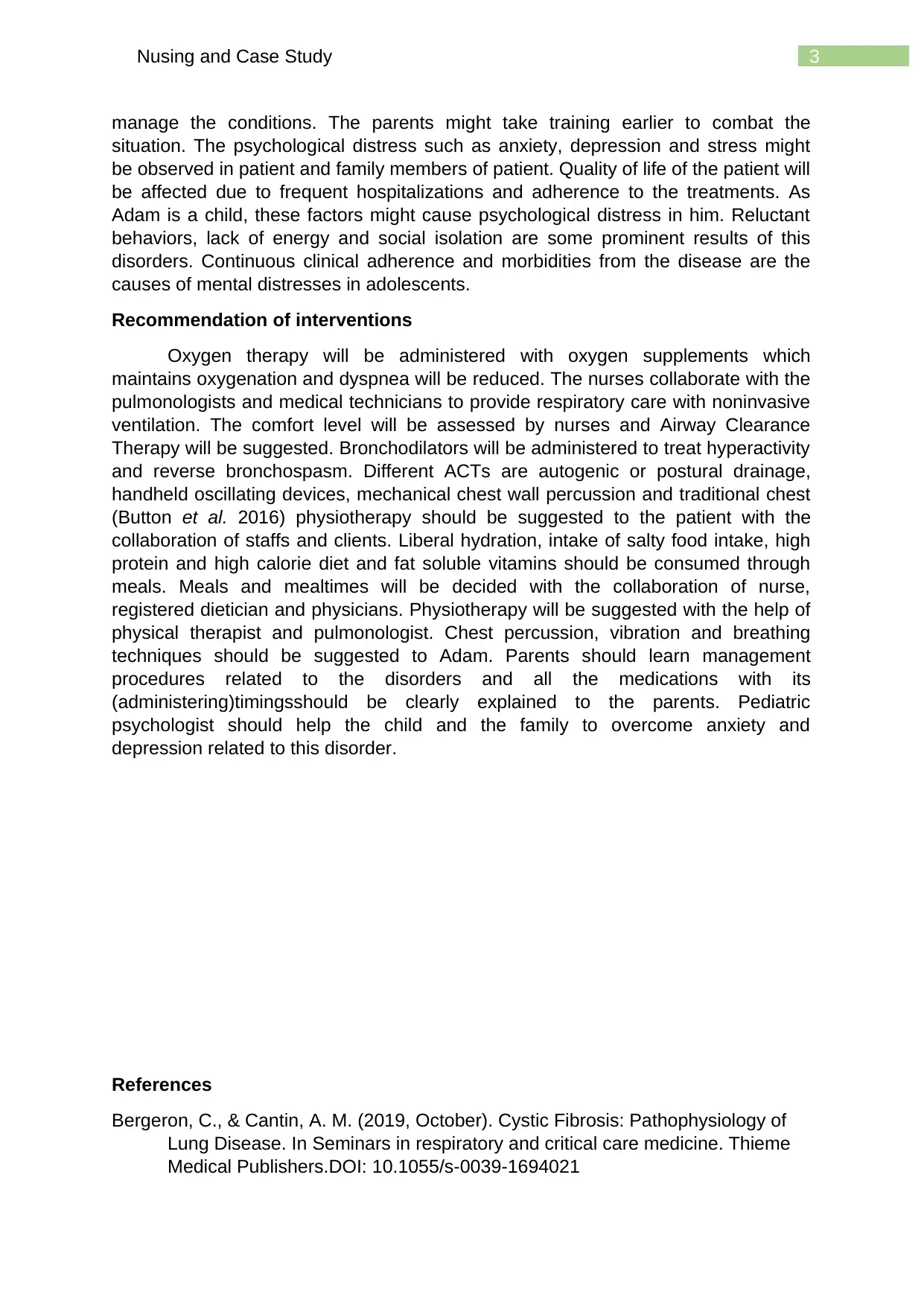
3Nusing and Case Study
manage the conditions. The parents might take training earlier to combat the
situation. The psychological distress such as anxiety, depression and stress might
be observed in patient and family members of patient. Quality of life of the patient will
be affected due to frequent hospitalizations and adherence to the treatments. As
Adam is a child, these factors might cause psychological distress in him. Reluctant
behaviors, lack of energy and social isolation are some prominent results of this
disorders. Continuous clinical adherence and morbidities from the disease are the
causes of mental distresses in adolescents.
Recommendation of interventions
Oxygen therapy will be administered with oxygen supplements which
maintains oxygenation and dyspnea will be reduced. The nurses collaborate with the
pulmonologists and medical technicians to provide respiratory care with noninvasive
ventilation. The comfort level will be assessed by nurses and Airway Clearance
Therapy will be suggested. Bronchodilators will be administered to treat hyperactivity
and reverse bronchospasm. Different ACTs are autogenic or postural drainage,
handheld oscillating devices, mechanical chest wall percussion and traditional chest
(Button et al. 2016) physiotherapy should be suggested to the patient with the
collaboration of staffs and clients. Liberal hydration, intake of salty food intake, high
protein and high calorie diet and fat soluble vitamins should be consumed through
meals. Meals and mealtimes will be decided with the collaboration of nurse,
registered dietician and physicians. Physiotherapy will be suggested with the help of
physical therapist and pulmonologist. Chest percussion, vibration and breathing
techniques should be suggested to Adam. Parents should learn management
procedures related to the disorders and all the medications with its
(administering)timingsshould be clearly explained to the parents. Pediatric
psychologist should help the child and the family to overcome anxiety and
depression related to this disorder.
References
Bergeron, C., & Cantin, A. M. (2019, October). Cystic Fibrosis: Pathophysiology of
Lung Disease. In Seminars in respiratory and critical care medicine. Thieme
Medical Publishers.DOI: 10.1055/s-0039-1694021
manage the conditions. The parents might take training earlier to combat the
situation. The psychological distress such as anxiety, depression and stress might
be observed in patient and family members of patient. Quality of life of the patient will
be affected due to frequent hospitalizations and adherence to the treatments. As
Adam is a child, these factors might cause psychological distress in him. Reluctant
behaviors, lack of energy and social isolation are some prominent results of this
disorders. Continuous clinical adherence and morbidities from the disease are the
causes of mental distresses in adolescents.
Recommendation of interventions
Oxygen therapy will be administered with oxygen supplements which
maintains oxygenation and dyspnea will be reduced. The nurses collaborate with the
pulmonologists and medical technicians to provide respiratory care with noninvasive
ventilation. The comfort level will be assessed by nurses and Airway Clearance
Therapy will be suggested. Bronchodilators will be administered to treat hyperactivity
and reverse bronchospasm. Different ACTs are autogenic or postural drainage,
handheld oscillating devices, mechanical chest wall percussion and traditional chest
(Button et al. 2016) physiotherapy should be suggested to the patient with the
collaboration of staffs and clients. Liberal hydration, intake of salty food intake, high
protein and high calorie diet and fat soluble vitamins should be consumed through
meals. Meals and mealtimes will be decided with the collaboration of nurse,
registered dietician and physicians. Physiotherapy will be suggested with the help of
physical therapist and pulmonologist. Chest percussion, vibration and breathing
techniques should be suggested to Adam. Parents should learn management
procedures related to the disorders and all the medications with its
(administering)timingsshould be clearly explained to the parents. Pediatric
psychologist should help the child and the family to overcome anxiety and
depression related to this disorder.
References
Bergeron, C., & Cantin, A. M. (2019, October). Cystic Fibrosis: Pathophysiology of
Lung Disease. In Seminars in respiratory and critical care medicine. Thieme
Medical Publishers.DOI: 10.1055/s-0039-1694021
Secure Best Marks with AI Grader
Need help grading? Try our AI Grader for instant feedback on your assignments.
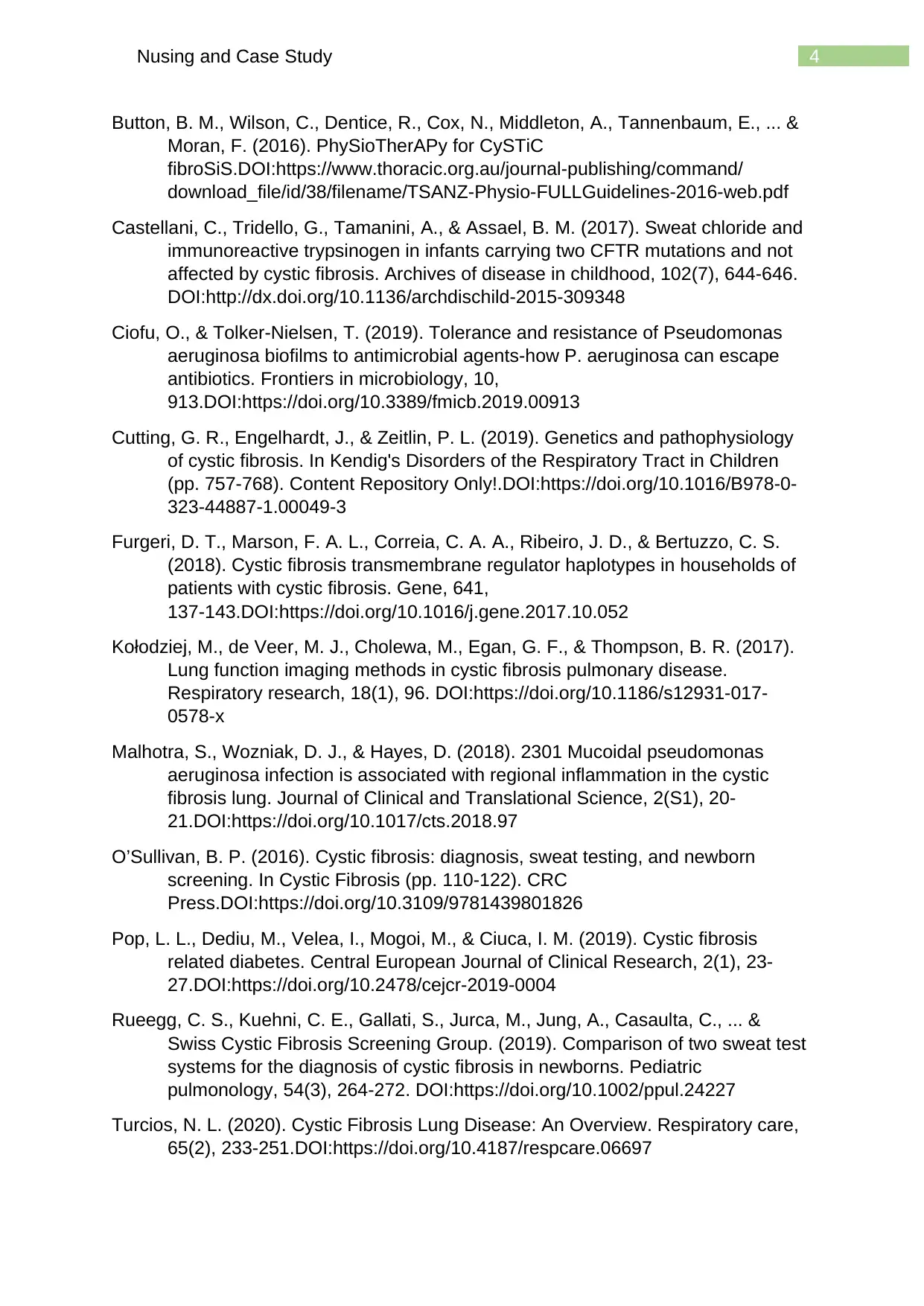
4Nusing and Case Study
Button, B. M., Wilson, C., Dentice, R., Cox, N., Middleton, A., Tannenbaum, E., ... &
Moran, F. (2016). PhySioTherAPy for CySTiC
fibroSiS.DOI:https://www.thoracic.org.au/journal-publishing/command/
download_file/id/38/filename/TSANZ-Physio-FULLGuidelines-2016-web.pdf
Castellani, C., Tridello, G., Tamanini, A., & Assael, B. M. (2017). Sweat chloride and
immunoreactive trypsinogen in infants carrying two CFTR mutations and not
affected by cystic fibrosis. Archives of disease in childhood, 102(7), 644-646.
DOI:http://dx.doi.org/10.1136/archdischild-2015-309348
Ciofu, O., & Tolker-Nielsen, T. (2019). Tolerance and resistance of Pseudomonas
aeruginosa biofilms to antimicrobial agents-how P. aeruginosa can escape
antibiotics. Frontiers in microbiology, 10,
913.DOI:https://doi.org/10.3389/fmicb.2019.00913
Cutting, G. R., Engelhardt, J., & Zeitlin, P. L. (2019). Genetics and pathophysiology
of cystic fibrosis. In Kendig's Disorders of the Respiratory Tract in Children
(pp. 757-768). Content Repository Only!.DOI:https://doi.org/10.1016/B978-0-
323-44887-1.00049-3
Furgeri, D. T., Marson, F. A. L., Correia, C. A. A., Ribeiro, J. D., & Bertuzzo, C. S.
(2018). Cystic fibrosis transmembrane regulator haplotypes in households of
patients with cystic fibrosis. Gene, 641,
137-143.DOI:https://doi.org/10.1016/j.gene.2017.10.052
Kołodziej, M., de Veer, M. J., Cholewa, M., Egan, G. F., & Thompson, B. R. (2017).
Lung function imaging methods in cystic fibrosis pulmonary disease.
Respiratory research, 18(1), 96. DOI:https://doi.org/10.1186/s12931-017-
0578-x
Malhotra, S., Wozniak, D. J., & Hayes, D. (2018). 2301 Mucoidal pseudomonas
aeruginosa infection is associated with regional inflammation in the cystic
fibrosis lung. Journal of Clinical and Translational Science, 2(S1), 20-
21.DOI:https://doi.org/10.1017/cts.2018.97
O’Sullivan, B. P. (2016). Cystic fibrosis: diagnosis, sweat testing, and newborn
screening. In Cystic Fibrosis (pp. 110-122). CRC
Press.DOI:https://doi.org/10.3109/9781439801826
Pop, L. L., Dediu, M., Velea, I., Mogoi, M., & Ciuca, I. M. (2019). Cystic fibrosis
related diabetes. Central European Journal of Clinical Research, 2(1), 23-
27.DOI:https://doi.org/10.2478/cejcr-2019-0004
Rueegg, C. S., Kuehni, C. E., Gallati, S., Jurca, M., Jung, A., Casaulta, C., ... &
Swiss Cystic Fibrosis Screening Group. (2019). Comparison of two sweat test
systems for the diagnosis of cystic fibrosis in newborns. Pediatric
pulmonology, 54(3), 264-272. DOI:https://doi.org/10.1002/ppul.24227
Turcios, N. L. (2020). Cystic Fibrosis Lung Disease: An Overview. Respiratory care,
65(2), 233-251.DOI:https://doi.org/10.4187/respcare.06697
Button, B. M., Wilson, C., Dentice, R., Cox, N., Middleton, A., Tannenbaum, E., ... &
Moran, F. (2016). PhySioTherAPy for CySTiC
fibroSiS.DOI:https://www.thoracic.org.au/journal-publishing/command/
download_file/id/38/filename/TSANZ-Physio-FULLGuidelines-2016-web.pdf
Castellani, C., Tridello, G., Tamanini, A., & Assael, B. M. (2017). Sweat chloride and
immunoreactive trypsinogen in infants carrying two CFTR mutations and not
affected by cystic fibrosis. Archives of disease in childhood, 102(7), 644-646.
DOI:http://dx.doi.org/10.1136/archdischild-2015-309348
Ciofu, O., & Tolker-Nielsen, T. (2019). Tolerance and resistance of Pseudomonas
aeruginosa biofilms to antimicrobial agents-how P. aeruginosa can escape
antibiotics. Frontiers in microbiology, 10,
913.DOI:https://doi.org/10.3389/fmicb.2019.00913
Cutting, G. R., Engelhardt, J., & Zeitlin, P. L. (2019). Genetics and pathophysiology
of cystic fibrosis. In Kendig's Disorders of the Respiratory Tract in Children
(pp. 757-768). Content Repository Only!.DOI:https://doi.org/10.1016/B978-0-
323-44887-1.00049-3
Furgeri, D. T., Marson, F. A. L., Correia, C. A. A., Ribeiro, J. D., & Bertuzzo, C. S.
(2018). Cystic fibrosis transmembrane regulator haplotypes in households of
patients with cystic fibrosis. Gene, 641,
137-143.DOI:https://doi.org/10.1016/j.gene.2017.10.052
Kołodziej, M., de Veer, M. J., Cholewa, M., Egan, G. F., & Thompson, B. R. (2017).
Lung function imaging methods in cystic fibrosis pulmonary disease.
Respiratory research, 18(1), 96. DOI:https://doi.org/10.1186/s12931-017-
0578-x
Malhotra, S., Wozniak, D. J., & Hayes, D. (2018). 2301 Mucoidal pseudomonas
aeruginosa infection is associated with regional inflammation in the cystic
fibrosis lung. Journal of Clinical and Translational Science, 2(S1), 20-
21.DOI:https://doi.org/10.1017/cts.2018.97
O’Sullivan, B. P. (2016). Cystic fibrosis: diagnosis, sweat testing, and newborn
screening. In Cystic Fibrosis (pp. 110-122). CRC
Press.DOI:https://doi.org/10.3109/9781439801826
Pop, L. L., Dediu, M., Velea, I., Mogoi, M., & Ciuca, I. M. (2019). Cystic fibrosis
related diabetes. Central European Journal of Clinical Research, 2(1), 23-
27.DOI:https://doi.org/10.2478/cejcr-2019-0004
Rueegg, C. S., Kuehni, C. E., Gallati, S., Jurca, M., Jung, A., Casaulta, C., ... &
Swiss Cystic Fibrosis Screening Group. (2019). Comparison of two sweat test
systems for the diagnosis of cystic fibrosis in newborns. Pediatric
pulmonology, 54(3), 264-272. DOI:https://doi.org/10.1002/ppul.24227
Turcios, N. L. (2020). Cystic Fibrosis Lung Disease: An Overview. Respiratory care,
65(2), 233-251.DOI:https://doi.org/10.4187/respcare.06697
1 out of 5
Related Documents
Your All-in-One AI-Powered Toolkit for Academic Success.
+13062052269
info@desklib.com
Available 24*7 on WhatsApp / Email
![[object Object]](/_next/static/media/star-bottom.7253800d.svg)
Unlock your academic potential
© 2024 | Zucol Services PVT LTD | All rights reserved.





